
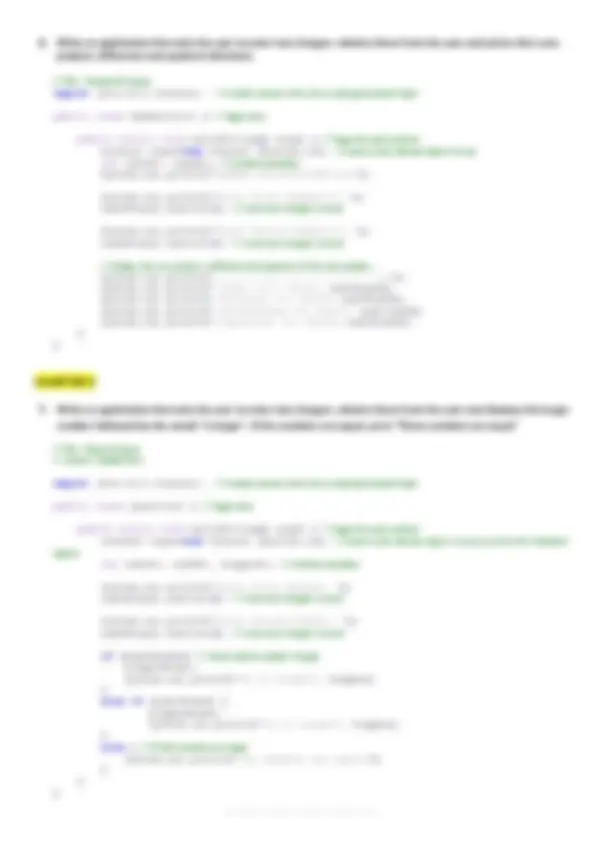
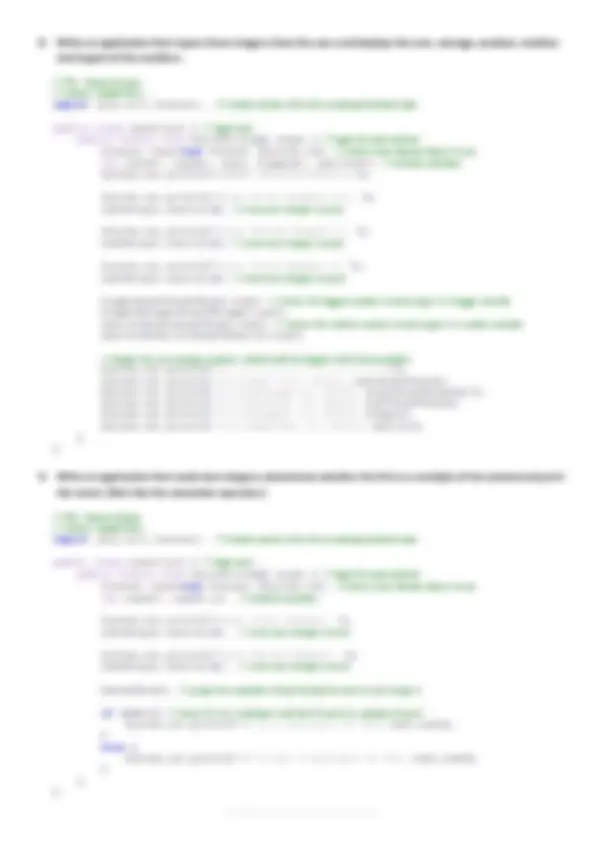
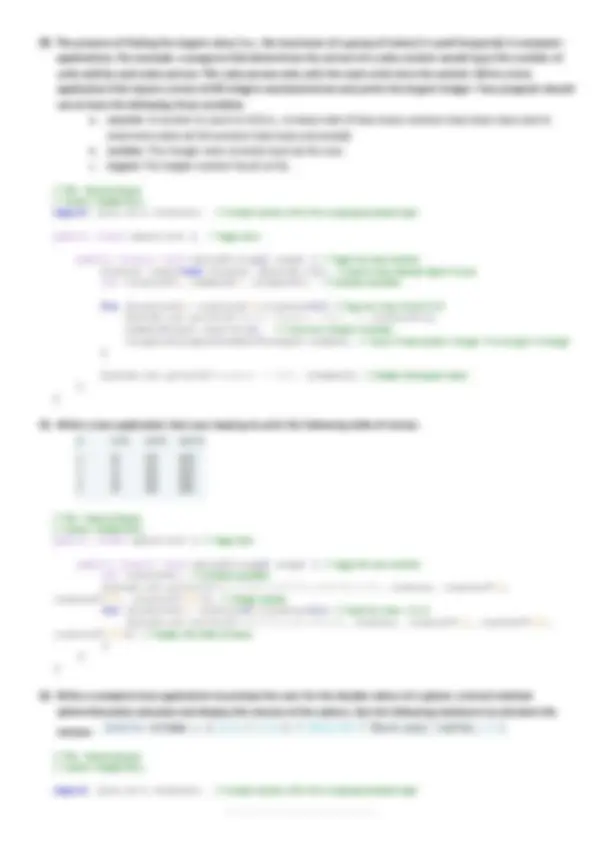
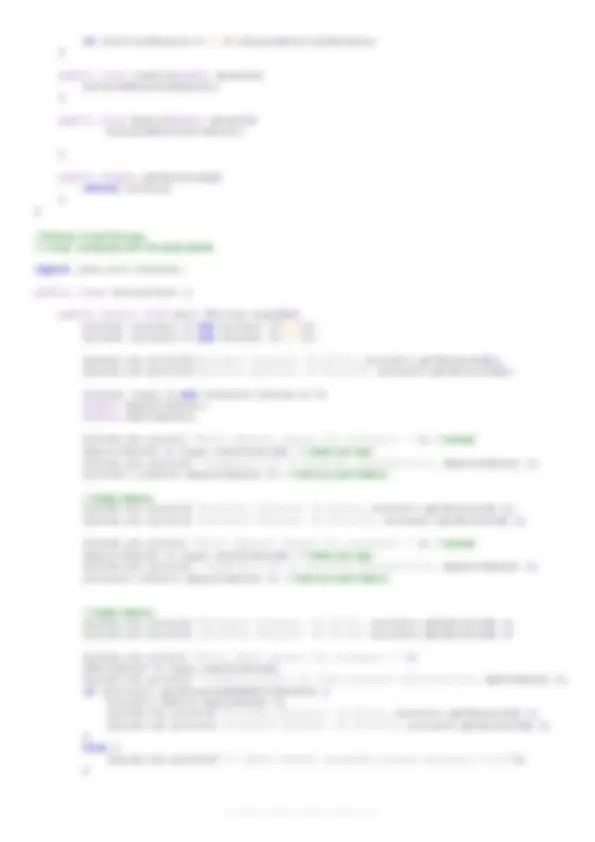
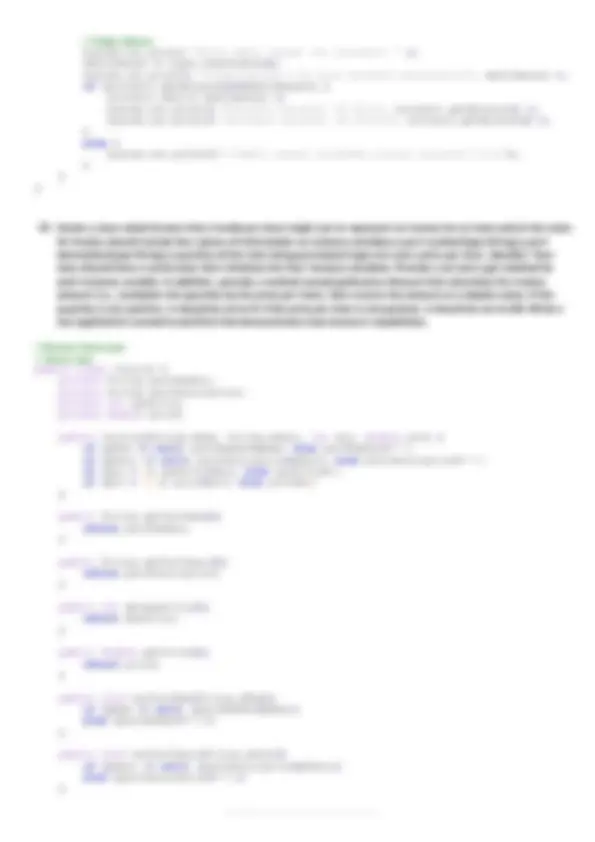
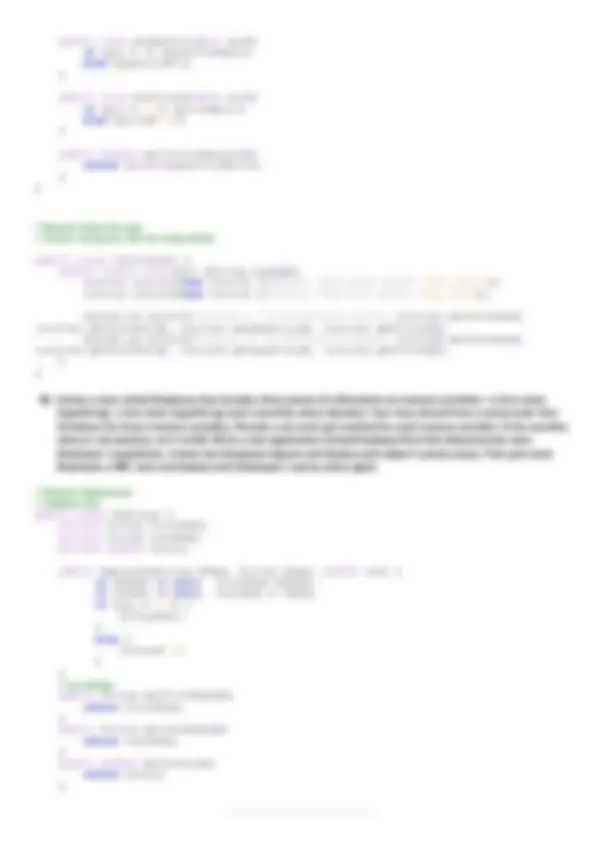
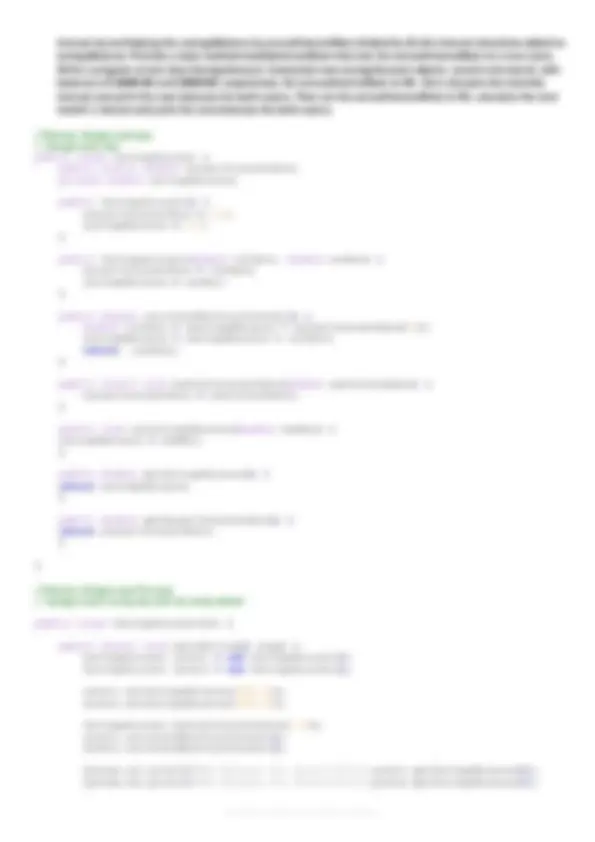
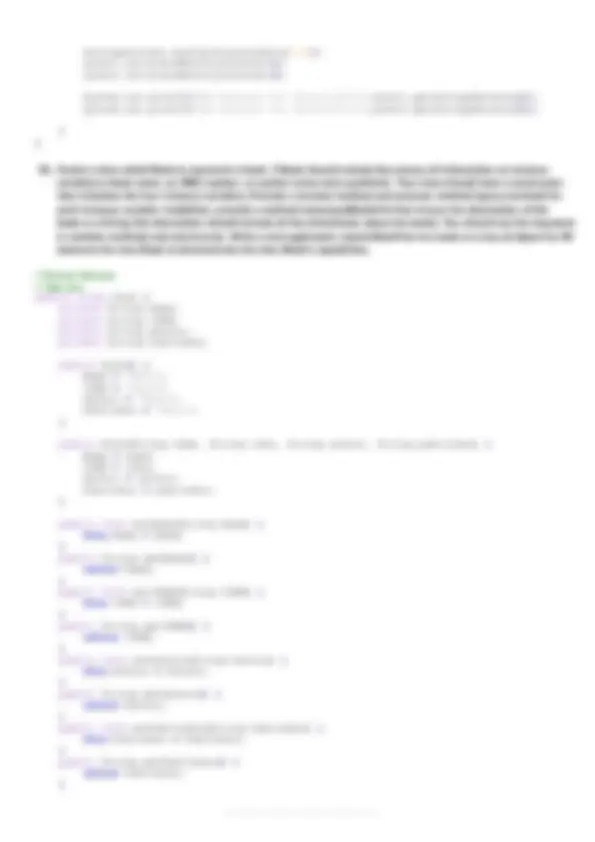
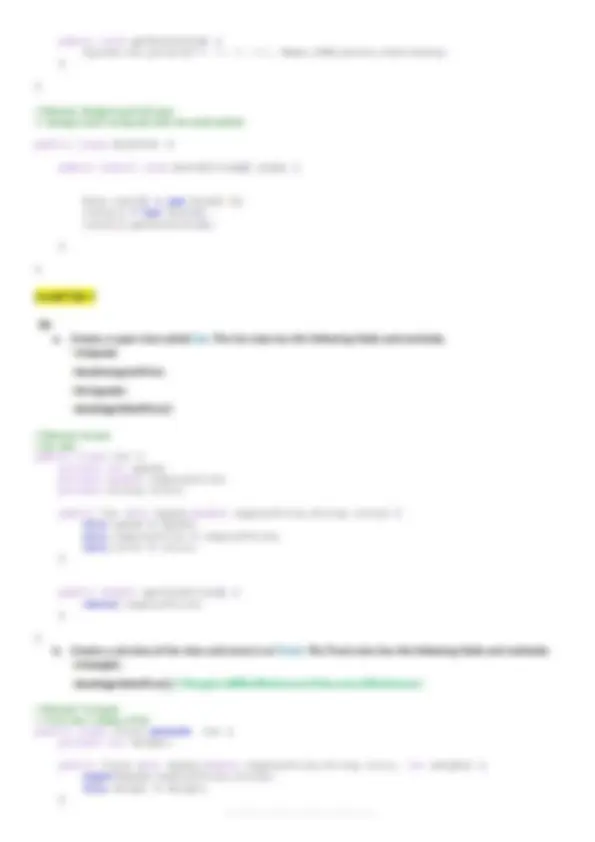
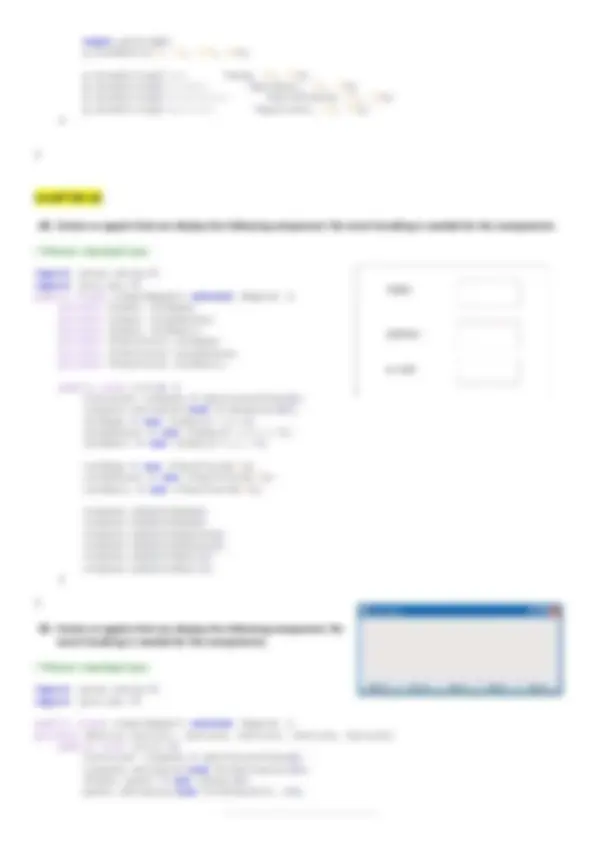
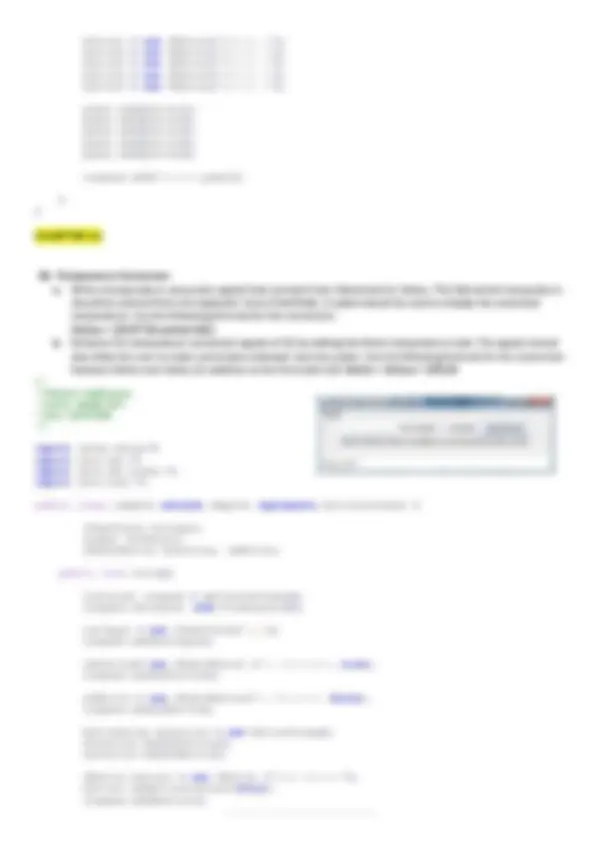



Study with the several resources on Docsity

Earn points by helping other students or get them with a premium plan


Prepare for your exams
Study with the several resources on Docsity

Earn points to download
Earn points by helping other students or get them with a premium plan
Community
Ask the community for help and clear up your study doubts
Discover the best universities in your country according to Docsity users
Free resources
Download our free guides on studying techniques, anxiety management strategies, and thesis advice from Docsity tutors
chapter 1.Write Text Based Application using Object Oriented Approach to Display your Name Cahpter 2.Write a Program that Calculate and Pint the Product of Three Integers.
Typology: Exercises
1 / 20

This page cannot be seen from the preview
Don't miss anything!













// filename: Name.java // Class containing display() method, notice the class doesnt have a main() method public class Name { public void display() { System.out.println("Mohamed Faisal"); } }
// filename: DisplayName.java // place in same folder as the Name.java file // Class containing the main() method public class DisplayName { public static void main(String[] args) { Name myname = new Name(); // creating a new object of Name class myname.display(); // executing the display() method in the Name class } }
// filename: DisplayNameApplet.java import java.applet.Applet; // import necessary libraries for an applet import java.awt.Graphics; public class DisplayNameApplet extends Applet { public void paint(Graphics g) { g.drawString("Mohamed Faisal", 50 , 25 ); } }
// filename: DisplayNameApplet.htm // place in same folder as the compiled DisplayNameApplet.class file
// filename: Q1.java import java.util.Scanner; // import Scanner libraries for input
public class Q1 {
public static void main(String[] args) { Scanner input = new Scanner (System.in);
int number1; int number2; int number3;
System.out.println("Enter the First Number");
number1 = input.nextInt();
System.out.println("Enter the Second Number"); number2 = input.nextInt();
System.out.println("Enter the Third Number"); number3 = input.nextInt();
System.out.printf("The product of three number is %d:", number1 * number2 * number3); }
}
// filename: Q2.java import java.util.*;
public class Q2 {
public static void main(String[] args) { Scanner input = new Scanner(System.in); double celsius; double tempInFahrenheit = 0.0;
celsius = (tempInFahrenheit - 32.0) * 5.0 / 9.0; System.out.println("Enter the fahrenheit value"); tempInFahrenheit = input.nextDouble();
System.out.printf("The celsious value of %10.2f is %2.2f",tempInFahrenheit, celsius); }
}
// filename: Printing.java public class Printing {
public static void main(String[] args) { int num1 = 1 ; int num2 = 2 ; int num3 = 3 ; int num4 = 4 ;
System.out.println(num1 + " " + num2 + " " + num3 + " " + num4);
System.out.print(num1 + " " + num2 + " " + num3 + " " + num4);
System.out.printf("\n%d %d %d %d",num1,num2,num3,num4); }
}
// File: Question2.java // Author: Abdulla Faris import java.util.Scanner; // include scanner utility for accepting keyboard input
public class Question2 { // begin class public static void main(String[] args) { // begin the main method Scanner input=new Scanner (System.in); //create a new Scanner object to use int num1= 0 , num2= 0 , num3, bigger= 0 , smaller= 0 ; // initialize variables System.out.printf("NUMBER CALCULATIONS\n\n");
System.out.printf("Enter First Number:\t\t "); num1=input.nextInt(); // store next integer in num
System.out.printf("Enter Second Number:\t "); num2=input.nextInt(); // store next integer in num
System.out.printf("Enter Third Number:\t "); num3=input.nextInt(); // store next integer in num
bigger=num1>num2?num1:num2; // checks the biggest number in and assigns it to bigger variable bigger=bigger>num3?bigger:num3; smaller=num1<num2?num1:num2; // checks the smallest number in and assigns it to smaller variable smaller=smaller<num3?smaller:num3;
// display the sum, average, product, smallest and the biggest of all three numbers System.out.printf("\t-------------------------\n"); System.out.printf("\t\t\tSum =\t\t %d\n", num1+num2+num3); System.out.printf("\t\t\tAverage =\t %d\n", (num1+num2+num3)/ 3 ); System.out.printf("\t\t\tProduct =\t %d\n", num1num2num3); System.out.printf("\t\t\tBiggest =\t %d\n", bigger); System.out.printf("\t\t\tSmallest =\t %d\n", smaller); } }
// File: Question3.java // Author: Abdulla Faris import java.util.Scanner; // include scanner utility for accepting keyboard input
public class Question3 { // begin class public static void main(String[] args) { // begin the main method Scanner input=new Scanner (System.in); //create a new Scanner object to use int num1= 0 , num2= 0 ,k; // initialize variables
System.out.printf("Enter First Number: "); num1=input.nextInt(); // store next integer in num
System.out.printf("Enter Second Number: "); num2=input.nextInt(); // store next integer in num
k=num2%num1; // assign the remainder ofnum2 divided by num1 to the integer k
if (k== 0 ){ // check if k is 0. remainder k will be 0 if num1 is a multiple of num2, System.out.printf("%d is a multiple of %d", num1,num2); } else { System.out.printf("%d is not a multiple of %d", num1,num2); } } }
// File: Question4.java // Author: Abdulla Faris import java.util.Scanner; // include scanner utility for accepting keyboard input
public class Question4 { // begin class
public static void main(String[] args) { // begin the main method Scanner input=new Scanner (System.in); //create a new Scanner object to use int counter= 0 , number= 0 , largest= 0 ; // initialize variables
for (counter= 0 ; counter< 10 ;counter++){ // loop ten times from 0 to 9 System.out.printf("Enter Number [%d]: ", counter+ 1 ); number=input.nextInt(); // store next integer in number largest=largest>number?largest:number; // check if new number is larger, if so assign it to larger }
System.out.printf("Largest = %d", largest); // display the largest value } }
// File: Question5.java // Author: Abdulla Faris public class Question5 { // begin class
public static void main(String[] args) { // begin the main method int counter= 1 ; // initialize variables System.out.printf("N\t10N\t100N\t1000N\n\n", counter, counter 10 , counter* 100 , counter* 1000 ); // display header for (counter= 1 ; counter<= 5 ;counter++){ // loop five times, 1 to 5 System.out.printf("%d\t%d\t%d\t%d\n", counter, counter* 10 , counter* 100 , counter* 1000 ); // display the table of values } } }
// File: Question6.java // Author: Abdulla Faris
import java.util.Scanner; // include scanner utility for accepting keyboard input
String str; //declaring a string variable str System.out.printf("Enter String: "); str=input.nextLine();// store next line in str
// display the same string in both uppercase and lowercase System.out.printf("%s%s",str.toUpperCase(),str.toLowerCase()); } }
// File: Question3.java // Author: Abdulla Faris
import java.util.Scanner; // include scanner utility for accepting input
public class Question3 {// begin class
public static double Average(int grades[], int max ) {// begin Average method int sum= 0 ; // initialize variables double average=0.0;
for (int i= 1 ;i<max;i++){ // loop and calculate the Average sum+=grades[i]; average=sum/(i); }
return average; // return the average after calculation
}
public static void main(String[] args) {// begin the main method
Scanner input=new Scanner(System.in); //create a new Scanner object to use
int i, grades[]; // initialize variables grades=new int[ 20 ];
for (i= 0 ;i< 20 ;i++){ // start to loop 20 times System.out.printf("Enter Grade: "); grades[i]=input.nextInt();// store next integer in grades[i] if (grades[i]==- 1 ) break; }
System.out.printf("%.2f", Average(grades, i- 1 )); } }
CHAPTER 5
//filename: Account.java // Accout class public class Account { private double balance;
public Account(double initialBalance) {
if (initialBalance > 0.0) balance=initialBalance; }
public void credit(double amount){ balance=balance+amount; }
public void debit(double amount){ balance=balance-amount;
}
public double getBalance(){ return balance; } }
//filename: AccountTest.java // Accout testing class with the main() method
import java.util.Scanner;
public class AccountTest {
public static void main (String args[]){ Account account1 = new Account (50.00); Account account2 = new Account (-7.53);
System.out.printf("Account1 Balance: $%.2f\n", account1.getBalance()); System.out.printf("Account2 Balance: $%.2f\n\n", account2.getBalance());
Scanner input = new Scanner( System.in ); double depositAmount; double debitAmount;
System.out.print( "Enter deposit amount for account1: " ); // prompt depositAmount = input.nextDouble(); // obtain user input System.out.printf( "\nadding %.2f to account1 balance\n\n", depositAmount ); account1.credit( depositAmount ); // add to account1 balance
// display balances System.out.printf( "Account1 balance: $%.2f\n", account1.getBalance() ); System.out.printf( "Account2 balance: $%.2f\n\n", account2.getBalance() );
System.out.print( "Enter deposit amount for account2: " ); // prompt depositAmount = input.nextDouble(); // obtain user input System.out.printf( "\nAdding %.2f to account2 balance\n\n", depositAmount ); account2.credit( depositAmount ); // add to account2 balance
// display balances System.out.printf( "Account1 balance: $%.2f\n", account1.getBalance() ); System.out.printf( "Account2 balance: $%.2f\n", account2.getBalance() );
System.out.print( "Enter debit amount for account1: " ); debitAmount = input.nextDouble(); System.out.printf( "\nSubtracting %.2f from account1 balance\n\n", debitAmount ); if (account1.getBalance()>=debitAmount) { account1.debit( debitAmount ); System.out.printf( "Account1 balance: $%.2f\n", account1.getBalance() ); System.out.printf( "Account2 balance: $%.2f\n\n", account2.getBalance() ); } else { System.out.printf("!!! Debit amount exceeded account balance!!!\n\n"); }
public void setQuantity(int qty){ if (qty > 0 ) {quantity=qty;} else {quantity= 0 ;} }
public void setPrice(double prc){ if (prc > 0.0) {price=prc;} else {price=0.0;} }
public double getInvoiceAmount(){ return (double)quantity*price; } }
//filename: InvoiceTest.java // Invoice testing class with the main() method
public class InvoiceTest { public static void main (String args[]){ Invoice invoice1=new Invoice ("A5544", "Big Black Book", 500 , 250.00); Invoice invoice2=new Invoice ("A5542", "Big Pink Book", 300 , 50.00);
System.out.printf("Invoice 1: %s\t%s\t%d\t$%.2f\n", invoice1.getPartNum(), invoice1.getPartDesc(), invoice1.getQuantity(), invoice1.getPrice()); System.out.printf("Invoice 2: %s\t%s\t%d\t$%.2f\n", invoice2.getPartNum(), invoice2.getPartDesc(), invoice2.getQuantity(), invoice2.getPrice()); } }
//filename: Employee.java // Employee class public class Employee { private String firstName; private String lastName; private double salary;
public Employee(String fName, String lName, double sal) { if (fName != null) firstName =fName; if (lName != null) lastName = lName; if (sal > 0.0) { salary=sal; } else { salary=0.0; } } //set methods public String getFirstName(){ return firstName; } public String getLastName(){ return lastName; } public double getSalary(){ return salary; }
//get methods public void setFirstName(String fName){ if (fName != null) firstName = fName; }
public void setLastName(String lName){ if (lName != null) lastName = lName; }
public void setSalary(double sal){ if (sal > 0.0){ salary = sal; } else { salary = 0.0; } }
}
//filename: EmployeeTest.java // Employee testing class with the main() method
public class EmployeeTest {
public static void main (String args[]){ Employee employee1=new Employee ("Mohamed", "Ali", 20000.00); Employee employee2=new Employee ("Ahmed", "Ibrahim", 50000.00);
System.out.printf("\nNO:\t NAME\t\t\tYEARLY SALARY\n"); System.out.printf("--\t ----\t\t\t-------------\n"); System.out.printf("1:\t %s %s\t\t$%.2f\n", employee1.getFirstName(), employee1.getLastName(), employee1.getSalary()); System.out.printf("2:\t %s %s\t\t$%.2f\n", employee2.getFirstName(), employee2.getLastName(), employee2.getSalary());
//set raise 10% employee1.setSalary( (.1employee1.getSalary())+employee1.getSalary()); employee2.setSalary( (.1employee2.getSalary())+employee2.getSalary());
System.out.printf("\n10 Percent Salary Raised!! Yoohooooo!\n"); System.out.printf("\nNO:\t NAME\t\t\tYEARLY SALARY\n"); System.out.printf("--\t ----\t\t\t-------------\n"); System.out.printf("1:\t %s %s\t\t$%.2f\n", employee1.getFirstName(), employee1.getLastName(), employee1.getSalary()); System.out.printf("2:\t %s %s\t\t$%.2f\n", employee2.getFirstName(), employee2.getLastName(), employee2.getSalary()); } }
//filename: Date.java // Date class public class Date { private int month; private int day; private int year;
public Date(int myMonth,int myDay, int myYear) {
//filename: SavingAccount.java // SavingAccount class public class SavingsAccount { public static double annualInterestRate; private double savingsBalance;
public SavingsAccount() { annualInterestRate = 0.0; savingsBalance = 0.0; }
public SavingsAccount(double intRate, double savBal) { annualInterestRate = intRate; savingsBalance = savBal; }
public double calculateMonthlyInterest() { double intRate = (savingsBalance * annualInterestRate/ 12 ); savingsBalance = savingsBalance + intRate; return intRate; }
public static void modifyInterestRate(double newInteresRate) { annualInterestRate = newInteresRate; }
public void setSavingsBalance(double newBal) { savingsBalance = newBal; }
public double getSavingsBalance() { return savingsBalance; }
public double getAnnualInterestRate() { return annualInterestRate; }
}
//filename: SavingsAccountTest.java // SavingsAccount testing class with the main() method
public class SavingsAccountTest {
public static void main(String[] args) { SavingsAccount saver1 = new SavingsAccount(); SavingsAccount saver2 = new SavingsAccount();
saver1.setSavingsBalance(2000.00); saver2.setSavingsBalance(3000.00);
SavingsAccount.modifyInterestRate(0.04); saver1.calculateMonthlyInterest(); saver2.calculateMonthlyInterest();
System.out.printf("New Balance for Saver1=%f\n",saver1.getSavingsBalance()); System.out.printf("New Balance for Saver2=%f\n",saver2.getSavingsBalance());
SavingsAccount.modifyInterestRate(0.05); saver1.calculateMonthlyInterest(); saver2.calculateMonthlyInterest();
System.out.printf("New Balance for Saver1=%f\n",saver1.getSavingsBalance()); System.out.printf("New Balance for Saver2=%f\n",saver2.getSavingsBalance());
} }
//filename: Book.java // Book class public class Book { private String Name; private String ISBN; private String Author; private String Publisher;
public Book() { Name = "NULL"; ISBN = "NULL"; Author = "NULL"; Publisher = "NULL"; }
public Book(String name, String isbn, String author, String publisher) { Name = name; ISBN = isbn; Author = author; Publisher = publisher; }
public void setName(String Name) { this.Name = Name; } public String getName() { return Name; } public void setISBN(String ISBN) { this.ISBN = ISBN; } public String getISBN() { return ISBN; } public void setAuthor(String Author) { this.Author = Author; } public String getAuthor() { return Author; } public void setPublisher(String Publisher) { this.Publisher = Publisher; } public String getPublisher() { return Publisher; }
public double getSalePrice() { if (weight > 2000 ){ return super.getSalePrice() - (0.1 * super.getSalePrice()); } else { return super.getSalePrice(); } } }
//filename: Ford.java // Ford class, subclass of Car public class Ford extends Car { private int year; private int manufacturerDiscount;
public Ford (int Speed,double regularPrice,String color, int year, int manufacturerDiscount) { super (Speed,regularPrice,color); this.year = year; this.manufacturerDiscount = manufacturerDiscount; }
public double getSalePrice() { return (super.getSalePrice() - manufacturerDiscount); } }
//filename: Sedan.java // Sedan class, subclass of Car public class Sedan extends Car { private int length;
public Sedan (int Speed,double regularPrice,String color, int length) { super (Speed,regularPrice,color); this.length = length; }
public double getSalePrice() { if (length > 20 ) { return super.getSalePrice() - (0.05 * super.getSalePrice()); } else { return super.getSalePrice() - (0.1 * super.getSalePrice()); } } }
//filename: MyOwnAutoShop.java // Testing class with the main() method public class MyOwnAutoShop { (int Speed,double regularPrice,String color, int year, int manufacturerDiscount)
public static void main(String[] args) { Sedan mySedan = new Sedan( 160 , 20000 , "Red", 10 ); Ford myFord1 = new Ford ( 156 ,4452.0,"Black", 2005 , 10 ); Ford myFord2 = new Ford ( 155 ,5000.0,"Pink", 1998 , 5 ); Car myCar - new Car ( 555 , 56856.0, "Red");
System.out.printf("MySedan Price %.2f", mySedan.getSalePrice()); System.out.printf("MyFord1 Price %.2f", myFord1.getSalePrice()); System.out.printf("MyFord2 Price %.2f", myFord2.getSalePrice()); System.out.printf("MyCar Price %.2f", myCar.getSalePrice());
}
}
CHAPTER 8
CHAPTER 9
//filename: simpleApplet1.java
import java.awt.; import javax.swing.;
public class simpleApplet1 extends JApplet { double sum; double product; double difference; double quotient;
public void init() { String firstNumber; String secondNumber;
double number1; double number2;
firstNumber = JOptionPane.showInputDialog("Enter the first number"); secondNumber = JOptionPane.showInputDialog("Enter the second number");
number1 = Double.parseDouble(firstNumber); number2 = Double.parseDouble(secondNumber);
sum = number1 + number2; product = number1 * number2; difference = number1 - number2; quotient = number1 % number2;
}
public void paint(Graphics g) {
button1 = new JButton("Button 1"); button2 = new JButton("Button 2"); button3 = new JButton("Button 3"); button4 = new JButton("Button 4"); button5 = new JButton("Button 5");
panel.add(button1); panel.add(button2); panel.add(button3); panel.add(button4); panel.add(button5);
conpane.add("South",panel);
} }
CHAPTER 11
/*
import javax.swing.; import java.awt.; import java.awt.event.; import java.text.;
public class tempCon extends JApplet implements ActionListener {
JTextField txtInput; JLabel lblResult; JRadioButton rbCelcius, rbKelvin;
public void init(){
Container conpane = getContentPane(); conpane.setLayout (new FlowLayout());
txtInput = new JTextField("", 10 ); conpane.add(txtInput);
rbCelcius= new JRadioButton ("to Celcius", true); conpane.add(rbCelcius);
rbKelvin = new JRadioButton("to Kelvin", false); conpane.add(rbKelvin);
ButtonGroup selection = new ButtonGroup(); selection.add(rbCelcius); selection.add(rbKelvin);
JButton button1 = new JButton ("Show Result"); button1.addActionListener(this); conpane.add(button1);
lblResult= new JLabel ("Enter Ferenheit, Choose an option to convert and Click Show Result"); conpane.add(lblResult); }
public void actionPerformed(ActionEvent e) {
DecimalFormat df = new DecimalFormat ("#.##"); double ferenheit = Double.parseDouble(txtInput.getText()); double answer = 0.0;
answer = ((5.0/9.0)*(ferenheit - 32.0));
if (rbKelvin.isSelected()) answer += 273.15;
lblResult.setText(String.valueOf(df.format(answer)));
} }